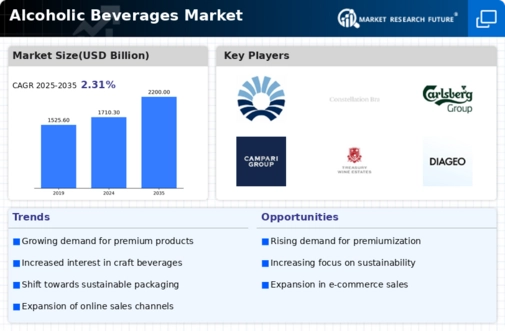Rising Consumer Demand
The Global Alcoholic Beverages Industry experiences a notable increase in consumer demand, driven by changing lifestyles and preferences. As of 2024, the market is valued at approximately 1710.3 USD Billion, reflecting a growing inclination towards premium and craft alcoholic beverages. This trend is particularly evident among millennials and Gen Z consumers, who seek unique flavors and experiences. The rise of social media platforms further amplifies this demand, as consumers share their experiences and recommendations. Consequently, brands are adapting their offerings to cater to these evolving preferences, indicating a dynamic shift in the market landscape.
Market Growth Projections
The Global Alcoholic Beverages Industry is poised for substantial growth, with projections indicating a market value of 2200 USD Billion by 2035. This growth trajectory is supported by a compound annual growth rate (CAGR) of 2.32% from 2025 to 2035. Various factors contribute to this optimistic outlook, including rising disposable incomes, evolving consumer preferences, and the expansion of distribution channels. As the market continues to evolve, stakeholders are likely to adapt their strategies to capitalize on emerging trends and consumer demands, ensuring sustained growth in this dynamic industry.
Expansion of E-commerce Channels
The Global Alcoholic Beverages Industry is witnessing a significant transformation with the expansion of e-commerce channels. Online sales of alcoholic beverages have surged, providing consumers with convenient access to a wide range of products. This trend is particularly pronounced in urban areas, where busy lifestyles limit traditional shopping methods. E-commerce platforms enable consumers to explore diverse brands and products, often at competitive prices. As a result, the market is projected to grow, with estimates suggesting a value of 2200 USD Billion by 2035. This shift towards online purchasing is likely to reshape distribution strategies within the industry.
Innovations in Product Development
The Global Alcoholic Beverages Industry is characterized by continuous innovations in product development. Companies are investing in research and development to create unique flavors, packaging, and experiences that resonate with consumers. This includes the introduction of flavored spirits, ready-to-drink cocktails, and sustainable packaging solutions. Such innovations not only attract new consumers but also encourage brand loyalty among existing customers. As the market evolves, these developments are likely to play a crucial role in maintaining competitiveness and driving growth. The emphasis on innovation aligns with the projected market value of 2200 USD Billion by 2035.
Cultural Influences and Globalization
The Global Alcoholic Beverages Industry is significantly influenced by cultural factors and globalization. As cultures intermingle, there is an increased appreciation for diverse alcoholic beverages from various regions. This cultural exchange fosters a demand for international brands and products, allowing consumers to explore flavors from around the world. Additionally, global travel and tourism contribute to this trend, as travelers seek to experience local beverages. This cultural integration not only enhances consumer knowledge but also drives market growth, as brands leverage these influences to expand their offerings and reach new audiences.
Health Consciousness and Low-Alcohol Options
The Global Alcoholic Beverages Market is adapting to a growing trend of health consciousness among consumers. As individuals become more aware of their health and wellness, there is an increasing demand for low-alcohol and non-alcoholic alternatives. This shift is reflected in the introduction of innovative products that cater to health-oriented consumers, such as low-calorie beers and alcohol-free spirits. Brands are responding by diversifying their portfolios to include these options, which not only appeal to health-conscious individuals but also attract a broader audience. This trend may contribute to sustained growth in the market, particularly as the CAGR is projected at 2.32% for 2025-2035.






















Leave a Comment